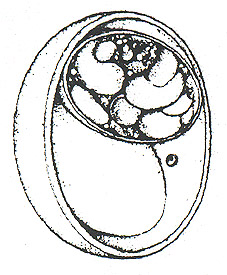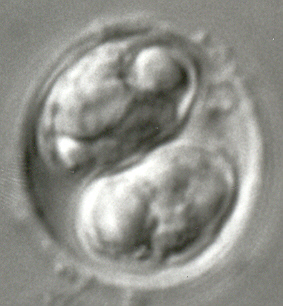Isospora dymecodi Duszynski and Moore, 1986
Type host: Urotrichus (syn. Dymecodon) pilirostris (True, 1886), Lesser Japanese shrew mole.
Other hosts: None reported to date.
Type locality: ASIA: Japan, Honshu, Yamagata Prefecture, 3.2 km E Zao-onsen.
Geographic distribution: ASIA: Japan, Honshu.


Description of oocyst:
Oocyst shape: subspheroid to ellipsoid;
number of walls: 1 obvious layer;
wall thickness: <1.0;
wall characteristics: smooth, of uniform thickness;
L x W: 15.8 x 12.6 (13-17 x 11-13);
L/W ratio: 1.25 (1.1-1.35);
M: absent;
OR: absent;
PG: 1.
Distinctive features of oocyst: small size and thin, one-layered wall.
Description of sporocysts and sporozoites:
Sporocyst shape: ellipsoid;
L x W: 10.9 x 6.9 (10-13 x 6-8);
L/W ratio: 1.6 (1.4-1.9);
SB: absent;
SSB: absent;
PSB: absent;
SR: present;
SR characteristics: a granular mass or a homogeneous, lipid-like body up to 5, or both are present;
SP: appear tightly coiled within sporocyst.
Distinctive features of sporocyst: absence of SB, SSB.
Prevalence: 6/6 (100%) U. pilirostris; 0/45 U. talpoides
Sporulation: Oocysts were sporulated when returned to the laboratory from the field.
Prepatent and patent periods: Unknown.
Site of infection: Unknown. Oocysts recovered from feces and intestinal contents.
Materials deposited: Skin, skull, skeleton and tissues of the symbiotype host are preserved in the Mammal Division of the Museum of SW Biology, UNM: MSB No. 45664 (NK 6449, male), D.W. Moore #900, 8 July, 1981. Photosyntypes in the USNPC No. 85990.
Remarks: Oocysts of this species resemble somewhat those of Isospora araneae Golemansky, 1978 from Sorex araneus and Isospora hylomysis Colley and Mullin, 1971 from Hylomys suillus. They differ by being smaller and more elongate than those of I. araneae, have only one obvious oocyst wall, and have smaller sporocysts with a larger mean L/W ratio (1.6 vs 1.3). They are larger than those of I. hylomysis, have a thinner oocyst wall that is not striated, and have larger sporocysts (11 x 7 vs 7 x 5).
References: Duszynski and Moore (1986).



